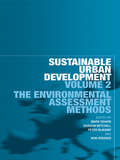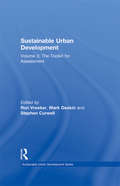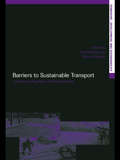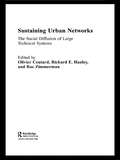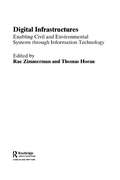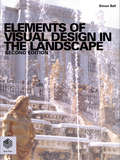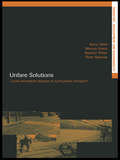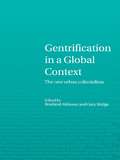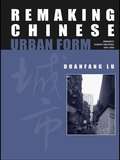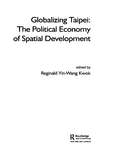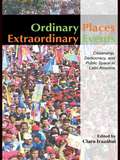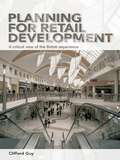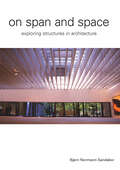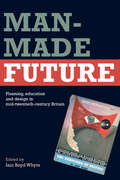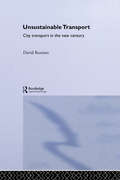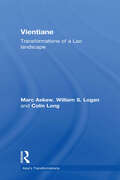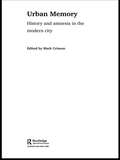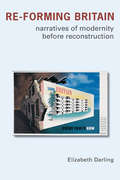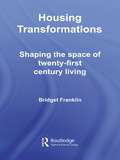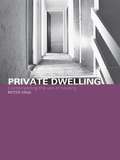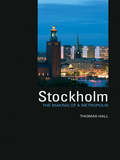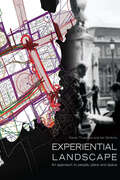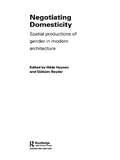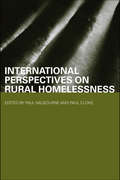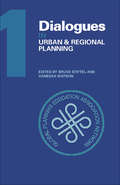- Table View
- List View
Sustainable Urban Development Volume 2: The Environmental Assessment Methods (Sustainable Urban Development Series #Vol. 2)
by Mark Deakin Gordon Mitchell Peter Nijkamp Ron VreekerIn this book, the second of a three-volume series, leading authorities on the methodology of environmental assessment provide a unique insight into questions of critical importance to sustainable urban development. Using the framework and protocols set out in Volume 1, Volume 2 examines how well the environmental assessment methods evaluate the ecological integrity of urban development and equity of the resulting resource distribution. The examination focuses on: the instruments of environmental assessment approaches to environmental assessment based in systems-thinking methods for environmental, economic and social assessments their use in evaluating the sustainability of urban development. The Sustainable Urban Development Series contains the research and debate of the BEQUEST (Building, Environmental Quality Evaluation for Sustainability) network funded by the European Commission. Together the books provide a framework, set of protocols, environmental assessment methods and toolkit for policy makers, academics, professionals and advanced level students in urban planning and studies, as well as other areas of the built environment.
Sustainable Urban Development Volume 3: The Toolkit for Assessment (Sustainable Urban Development Series)
by Ron Vreeker Mark Deakin Stephen CurwellThe third volume of the Sustainable Urban Development Series outlines the BEQUEST toolkit that helps link protocol with the assessment methods currently available for evaluating the sustainability of urban development. It details the decision support mechanisms developed for users of the system to guide them in selecting the appropriate assessment methods for a variety of evaluations.This book provides case studies drawn from locations across Europe, and also provides best practice examples demonstrating those protocols that planners, property developers and design and construction professionals have followed, and how they have selected the assessment methods they need to best evaluate the sustainability of cities, districts, neighbourhoods and buildings.
Barriers to Sustainable Transport: Institutions, Regulation and Sustainability (Transport, Development and Sustainability Series)
by Piet Rietveld Roger R. StoughThe complexity of transportation systems and their negative social and environmental effects are today at the centre of attention. This book focuses on the impact of institutions and regulatory systems on transport systems and travel behaviour. While institutions appear to play an important role in the economic success of many countries, this book considers the extent to which they also support sustainable development.
Sustaining Urban Networks: The Social Diffusion of Large Technical Systems (Networked Cities Series)
by Olivier Coutard Richard E. Hanley Rae ZimmermanConsidering sustainability in its economic, environmental and social contexts, the contributors take stock of previous research on large technical systems and discuss their sustainability from three main perspectives: uses, cities, and rules and institutions.
Digital Infrastructures: Enabling Civil and Environmental Systems through Information Technology (Networked Cities Series)
by Rae Zimmerman Thomas HoranAn invisible network of digital technology systems underlies the highly visible networks of roads, waterways, satellites, and power-lines. Increasingly, these systems are becoming the "infrastructure's infrastructure," providing a crucial array of data on network demand, performance, reliability, and security. Digital Infrastructures presents an interdisciplinary analysis of the technological systems that envelop these networks. The book balances analyses of specific civil and environmental infrastructures with broader policy and management issues, including the challenges of using IT to manage these critical systems under crises conditions.
Elements of Visual Design in the Landscape
by Simon BellPublic concern about the landscape, in particular its appearance, is increasing all the time. For those charged with managing, developing or conserving a wide range of landscapes it is a major task to take visual aspects into account. Elements of Visual Design in the Landsacpe presents a vocabulary of visual design, structured in a logical and easy to follow sequence. It is profusely illustrated using both abstract and real examples taken from a wide range of international locations together with cross referencing between related principles and case studies demonstrating how the principles can be applied in practice. The visual aspects of design have often been treated as 'cosmetic' and therefore not meriting attention or purely subjective and therefore open to personal preference. Few attempts have been made to explain how we see the landscape in any rational and structured way, and to demonstrate how visually creative design and management can be undertaken. This book aims to fill that gap.
Unfare Solutions: Local Earmarked Charges to Fund Public Transport (Transport, Development and Sustainability Series)
by Barry Ubbels Marcus Enoch Stephen Potter Peter NijkampTransport policy is an increasingly difficult area for all national governments and regional/local authorities. Tackling car use and realising a sustainable transport system appears to be very difficult. Developing public transport is seen as an increasingly important element in improving the transport system, especially in densely populated areas. At the same time however, governments are under increasing pressure to cut taxation. As a result there is a growing gap between increasing policy need for public transport and government resources to fund that need. This timely book explores one solution to this dilemma, which is the use of local charges and taxes dedicated to support public transport. Unfare Solutions examines how and why such charges have evolved and how they do (or do not) relate to modern transport policy developments and theory. It shows innovative funding techniques developed by both public transport providers and federal and local authorities.
Gentrification in a Global Context: The New Urban Colonialism (Housing and Society Series)
by Gary Bridge Rowland AtkinsonGentrification, a process of class neighbourhood upgrading, is being identified in a broader range of urban contexts throughout the world. This book throws new light and evidence to bear on a subject that deeply divides commentators on its worth and social costs given its ability to physically improve areas but also to displace indigenous inhabitants.Gentrification in a Global Perspective brings together the most recent theoretical and empirical research on gentrification at a global scale. Each author gives an overview of gentrification in their country so that each chapter retains a unique approach but tackles a common theme within a shared framework. The main feature of the book is a critical and well-written set of chapters on a process that is currently undergoing a resurgence of interest and one that shows no sign of abating.
Remaking Chinese Urban Form: Modernity, Scarcity and Space, 1949-2005 (Planning, History and Environment Series)
by Duanfang LuIn this pioneering study of contemporary Chinese urban form, Duanfang Lu provides an analysis of how Chinese society constructed itself through the making and remaking of its built environment. She shows that as China’s quest for modernity created a perpetual scarcity as both a social reality and a national imagination, the realization of planning ideals was postponed. The work unit – the socialist enterprise or institute – gradually developed from workplace to social institution which integrated work, housing and social services. The Chinese city achieved a unique geography made up in large part of self-contained work units. Remaking Chinese Urban Form provides an important reference for academics and students conducting research on China. It will be a key source for courses on Asia in architecture, urban planning, geography, sociology and anthropology, at both the graduate and undergraduate level. The insightful yet accessible introduction to urban China will also be of interest to architects, urban designers and planners – as well as general audience who wish to learn about contemporary Chinese society.
Globalizing Taipei: The Political Economy of Spatial Development (Planning, History and Environment Series)
by Reginald Yin-Wang KwokTaipei's quest to become a global city is the key to its urban development. Globalizing Taipei looks at this "Asian Dragon", a major city in the South China Growth Triangle and a centre for transnational production, revealing how the development of this capital has received firm state support but is conditioned by international and domestic politics.The book is divided into four parts: economic and spatial restructuring, state and society realignment, social differentiation and cultural reorientation. Each analyzes the interaction of international, state and local politics in the shaping of the city's urban environment since World War II.All contributors to this edited volume are Taiwan scholars presenting critical insiders' views. Based on each author's specialization and research focus, each chapter provides an in-depth consideration of one of Taipei's developmental issues generated by globalization. Collectively they provide broad, insightful and coherent coverage of this crucial time in Taipei's global transmutation.
Ordinary Places/Extraordinary Events: Citizenship, Democracy and Public Space in Latin America (Planning, History and Environment Series)
by Clara IrazábalClara Irazábal and her contributors explore the urban history of some of Latin America’s great cities through studies of their public spaces and what has taken place there. The avenues and plazas of Mexico City, Havana, Santo Domingo, Caracas, Bogotaì, SaÞo Paulo, Lima, Santiago, and Buenos Aires have been the backdrop for extraordinary, history-making events. While some argue that public spaces are a prerequisite for the expression, representation and reinforcement of democracy, they can equally be used in the pursuit of totalitarianism. Indeed, public spaces, in both the past and present, have been the site for the contestation by ordinary people of various stances on democracy and citizenship. By exploring the use and meaning of public spaces in Latin American cities, this book sheds light on contemporary definitions of citizenship and democracy in the Americas.
Planning for Retail Development: A Critical View of the British Experience
by Clifford GuyWritten by a leading expert in the field, this is the first thorough critical review of retail planning policy in Britain (including Scotland and Wales). It covers recent changes in government policy and guidance, and examines retail policy within a broader economic and social context. Planning for Retail Development explains key events and debates in the evolution of retail planning policy, at central and local government levels, since the 1960s and draws contrasts between the 1980s, a period in which retail developers were encouraged by central government to expand away from town centres, and the more recent emphasis on protection and promotion of town centres as the most appropriate location for new development. The book develops a critical evaluation of past and present retail planning policies, based upon analyses of retailers’ objectives and of typical consumer shopping behaviour. Relationships between retail planning and wider societal concerns, including sustainable development, social inclusion and urban regeneration are also examined and analysed and guidelines for future policy objectives and content are drawn.
On Span and Space: Exploring Structures in Architecture
by Bjorn N. SandakerIn this richly illustrated book with many practical examples, Bjorn Sandaker provides readers with a better understanding of the relationship between technology and architecture. As an experienced teacher and writer, Sandaker offers a well-founded aesthetic theory to support the understanding and evaluation of a structure's form and design, examining concepts and viewpoints from both the professions of engineering and architecture. Comprehensively covering structure and aesthetics, this book is ideal for students, professionals and academics in the areas of architecture and building.
Man-Made Future: Planning, Education and Design in Mid-20th Century Britain
by Iain Boyd WhyteThis anthology of essays by a group of distinguished scholars investigates post-1945 city planning in Britain; not from a technical viewpoint, but as a polemical, visual and educational phenomenon, shifting the focus of scholarly interest towards the often-neglected emotional and aesthetic aspects of post-war planning. Each essay is grounded in original archival research and sheds new light on this critical era in the development of modern town planning. This collection is a valuable resource for architectural, social and urban historians, as well as students and researchers offering new insights into the development of the mid-twentieth century city.
Unsustainable Transport: City Transport in the New Century (Transport, Development and Sustainability Series)
by David BanisterThis book addresses the links between transport and sustainable urban development, from an analysis of the global picture to issues in transport and energy intensity, public policy and the institutional and organisational constraints on change. The central part of the book explores these links in more detail at city level, covering land use and development, economic measures, and the role that technology can play. The final part looks for inspiration from events in developing countries and the means by which we can move from the unsustainable present to a more sustainable future.
Vientiane: Transformations of a Lao landscape (Routledge Studies in Asia's Transformations)
by William Logan Colin Long Marc AskewProviding insights into this neglected Southeast Asian city, this interesting book interprets Vientiane’s landscape - physical as well as imagined - as a reflection of key aspects of Lao geo-political history, the nature of Lao urbanism, and its critical relation to constructions of Lao identity in the contemporary period. It is argued that the patterns of change seen through Vientiane’s past embody the key political and economic processes and transformations impacting on the people of Laos. The Lao urban past has rarely been an object of attention by scholars. Laos, in fact, is continually portrayed as a rural backwater, marginal to the dynamic trends affecting most of the Southeast Asian mainland. In contrast to these persistent and static portrayals of Laos as a tiny landlocked backwater, with no significant urban present or past, the authors aim to document, explain and evaluate the significance of the Lao urban landscape. Focusing on the theme of Vientiane’s ‘marginality’ in its various forms, the book interprets this apparent marginality as an historically-produced phenomenon resulting from geo-politics dating from the pre-colonial period and extending into the post-colonial period. Drawing on a wide range of research materials, Vientiane is the first work of its kind on this ignored city.
Urban Memory: History and Amnesia in the Modern City
by Mark CrinsonNine previously unpublished essays form an interdisciplinary assessment of urban memory in the modern city, analysing this burgeoning area of interest from the perspectives of sociology, architectural and art history, psychoanalysis, culture and critical theory. Featuring a wealth of illustrations, images, maps and specially commissioned artwork, this work applies a critical and creative approach to existing theories of urban memory, and examines how these ideas are actualised in the forms of the built environment in the modernist and post-industrial city. A particular area of focus is post-industrial Manchester, but the book also includes studies of current-day Singapore, New York after 9/11, modern museums in industrial gallery spaces, the writings of Paul Auster and W.G. Sebald, memorials built in concrete, and contemporary art.
Re-forming Britain: Narratives of Modernity before Reconstruction
by Elizabeth DarlingRe-forming Britain considers the nature and practice of architectural modernism in inter-war Britain in a new light. Bringing hitherto little considered protagonists and projects to the fore, it argues that rather than being an imported idiom, the new architecture in Britain formed part of an ongoing attempt to make a modern nation. Spanning the period 1925-42, the book focuses on the key sites from and through which architectural modernism emerged in the UK. Part one considers the main arena in which a will to modernize Britain developed in the 1920s. In parts two and three the author documents, contextualizes and explains how this modernizing will was given modernist form, discussing the work of architects such as Wells Coates, Maxwell Fry, and Connell and Ward, and their allied ventures with likeminded reformers in other fields. These collaborations produced ‘narratives of modernity’: buildings, projects, exhibitions and books, through which, the book argues, modernist reformers were able to persuade politicians, and those with influence upon them, that modernism was the means to re-form the nation. Re-forming Britain offers the first in-depth analysis of well-known modernist schemes such as Kensal House and the Pioneer Health Centre but also brings previously little studied or unknown activities to light. This important work invites a new understanding of the nature of architectural modernism in inter-war Britain and the ways in which it ultimately gave form to post-war Britain.
Housing Transformations: Shaping the Space of Twenty-First Century Living (Housing and Society Series)
by Bridget FranklinDrawing together a wide range of literature, this original book combines social theory with elements from the built environment disciplines to provide insight into how and why we build places and dwell in spaces that are at once contradictory, confining, liberating and illuminating. This groundbreaking book deals with topical issues, which are helpfully divided into two parts. The first presents a conceptual framework examining how the built environment derives from a variety of influences: structural, institutional, textual, and action-orientated. Using illustrated case study examples, the second part covers new build schemes, including urban villages, gated communities, foyers, retirement homes and televillages, as well as refurbishment projects, such as mental hospitals and tower blocks. Multidisciplinary in its focus, Housing Transformations will appeal to academics, students and professionals in the fields of housing, planning, architecture and urban design, as well as to social scientists with an interest in housing.
Private Dwelling: Contemplating the Use of Housing (Housing, Planning and Design Series)
by Peter KingHousing is something that is deeply personal to us. It offers us privacy and security and allows us to be intimate with those we are close to. This book considers the nature of privacy but also how we choose to share our dwelling. The book discusses the manner in which we talk about our housing, how it manifests and assuages our anxieties and desires and how it helps us come to terms with loss.Private Dwelling offers a deeply original take on housing. The book proceeds through a series of speculations, using philosophical analysis and critique, personal anecdote, film criticism, social and cultural theory and policy analysis to unpick the subjective nature of housing as a personal place where we can be sure of ourselves.
Stockholm: The Making of a Metropolis (Planning, History and Environment Series)
by Thomas HallThis is the first history of Stockholm’s development from the city’s unique seventeenth-century redevelopment and extension to the postmodern, postindustrial trends of today. While the city’s planners borrowed the ideas from abroad at certain periods, they provided the lead for the rest of the world at others. For much of the mid-twentieth century Stockholm was the model for Europe and elsewhere. Written by an acknowledged authority on the city and Swedish architecture and planning generally, with a wide range of illustrations, this book provides a much needed explanation of one of Europe’s great cities.
Experiential Landscape: An Approach to People, Place and Space
by Kevin Thwaites Ian SimkinsExperiential Landscape offers new ways of looking at the relationship between people and the outdoor open spaces they use in their everyday lives. The book takes a holistic view of the relationship between humans and their environment, integrating experiential and spatial dimensions of the outdoors, and exploring the theory and application of environmental design disciplines, most notably landscape architecture and urban design. The book explores specific settings in which an experiential approach has been applied, setting out a vocabulary and methods of application, and offers new readings of experiential characteristics in site analysis and design. Offering readers a range of accessible mapping tools and details of what participative approaches mean in practice, this is a new, innovative and practical methodology. The book provides an invaluable resource for students, academics and practitioners and anyone seeking reflective but practical guidance on how to approach outdoor place-making or the analysis and design of everyday outdoor places.
Negotiating Domesticity: Spatial Productions of Gender in Modern Architecture
by Hilde Heynen Gülsüm BaydarIn the home the intricate relations between architecture, gender and domesticity become visible. Negotiating Domesticity investigates the many and complex themes evoked by the interconnections between these terms. Topics covered include famous as well as less well-known architectural examples and architects, which are explored from sociological, anthropological, philosophical and psychoanalytical approaches. The authors explore the relationships between modern domestic spaces and sexed subjectivities in a broad range of geographical locations of Western modernity. This richly interdisiplinary work presents architects and postgraduate students with an in-depth exploration of domesticity in the modern era.
International Perspectives on Rural Homelessness (Housing, Planning and Design Series)
by Paul Milbourne Paul ClokeDrawing on recent academic studies in North America, Europe, Australia and New Zealand, this book is the first international text on homelessness in rural areas. Consisting of fifteen specially commissioned chapters, International Perspectives on Rural Homelessness provides comparative material on the cultural, political and policy contexts of rural homelessness, examining the nature and scale of the issue and the complex local geographies of rural homelessness.
Dialogues in Urban and Regional Planning: Volume 1
by Bruce Stiftel Vanessa WatsonDialogues in Urban and Regional Planning offers a selection of the best urban planning scholarship from each of the world's planning school associations. The award-winning papers presented illustrate the concerns and the discourse of planning scholarship communities and provide a glimpse into planning theory and practice by planning academics around the world. All those with an interest in urban and regional planning will find this collection valuable in opening new avenues for research and debate.This book is published in association with the Global Planning Education Association Network (GPEAN), and the nine planning school associations it represents, who have selected these papers based on regional competitions.
